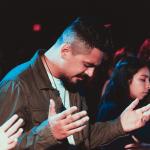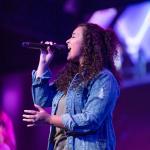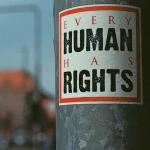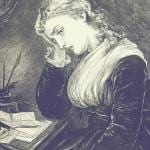John ascends through a door in heaven, powered by the Spirit and the trumpet-voice of Jesus (Revelation 4:1-2). A complicated scene greets him in the heavenly temple/throne room.
There are several pieces to the tableau: a throne, a rainbow, 24 additional thrones, seven lamps, a sea like glass, and four living creatures. The spatial relations between these things are subtle.
The throne is at the center, and it is occupied by an Enthroned One, who is epi the throne. The rainbow circles around (kuklothen)_ the throne, and so do the 24 thrones, on which the ancient ones sit. That perhaps identifies the rainbow with the enthroned elders: With their white robes and golden crowns, they form the emerald rainbow.
Perhaps the seven lamps before (enopion) the throne are nearer the throne than the sea, which is also before (enopion) the throne, but that is a supposition based only on the fact that the lamps are mentioned first. The four living creatures are in the middle of the throne (en meso) and also around it (kuklo). Given the placement of cherubic figures elsewhere in the Bible, I suggest that the living beings actually constitute the throne. Though complicated, the arrangement resembles the arrangement of the temple: Yahweh’s cherub-throne is in the most holy place; lampstands are in the holy place; the sea is in the courtyard. What’s new in Revelation are the rainbow (which appears in Ezekiel) and the placement of the white-robed priests.
The somewhat turgid phrasing of John’s description seems to be intended to bring out the theology of the scene. I’ve already noted that the ancient ones and the rainbow are in the same position “around” the throne, suggesting a connection between priests and the covenant sign of the rainbow.
Other parallels and patterns of phrasing bring out other aspects. In verses 2-4, the prepositions form a chiasm: epi, kuklothen, kuklothen, epi. Both of the epi phrases have thronon as object, and both describe “sitting” figures: The first states that a Seated One is on the throne, while the second phrase says that the 24 presbyteroi are seated on their thrones. The patterned phrasing highlights the connection between the one enthroned and the ones enthroned, between the eternal Father and the ancient ones seated around Him.
Another striking phrasal repetition occurs in the description of the One enthroned and the rainbow that surrounds Him. He is like jasper stone and sardius in appearance (homoios orasei litho iaspidi kai sarido); the rainbow is homoios orasei smaragdino, like emerald in appearance. Both rainbow and Enthroned one are compared to precious stones, and compared with nearly identical phrases. The phrasing reinforces the content of the descriptions, which brings out the lithic similarities between the enthroned One and the rainbow (which may be identical to the enthroned ones). With the sea turned to crystal, the whole heavenly scene gleams with precious gems, recalling the breastplate of the high priest and anticipating the jeweled city that will descend from heaven at the end of the book.











